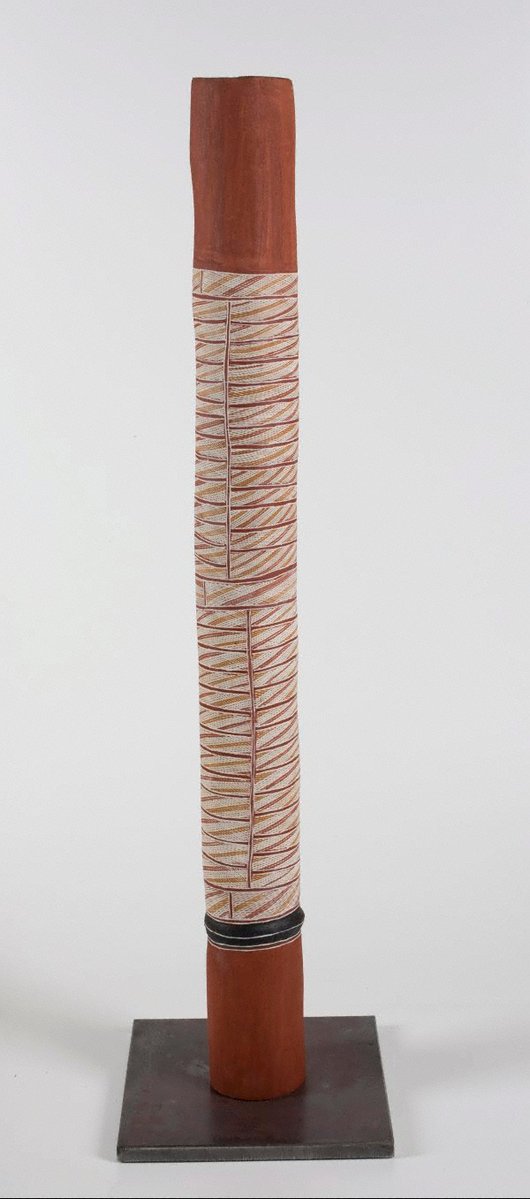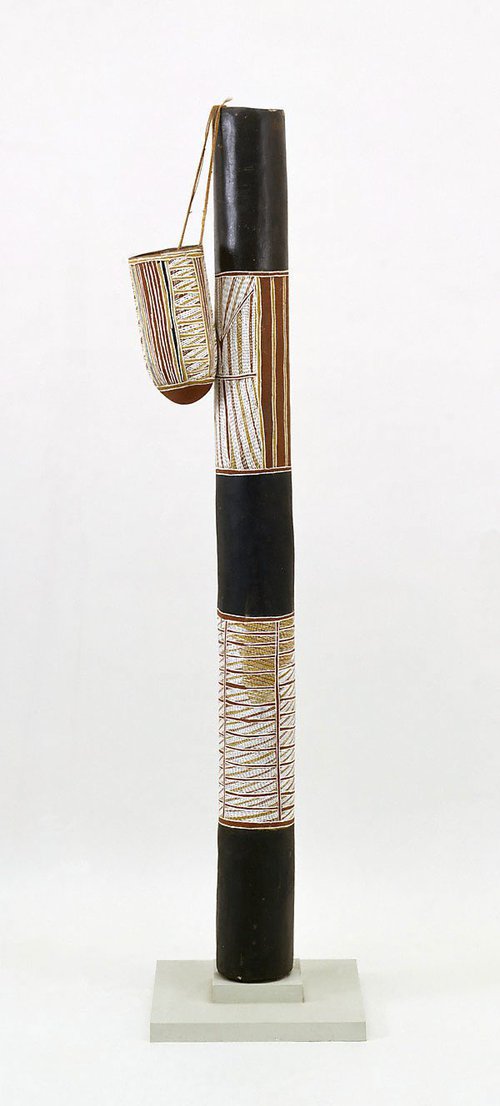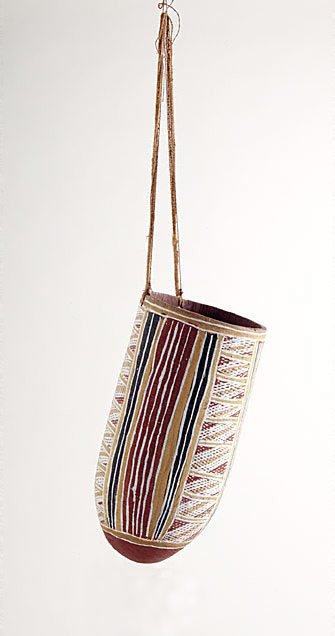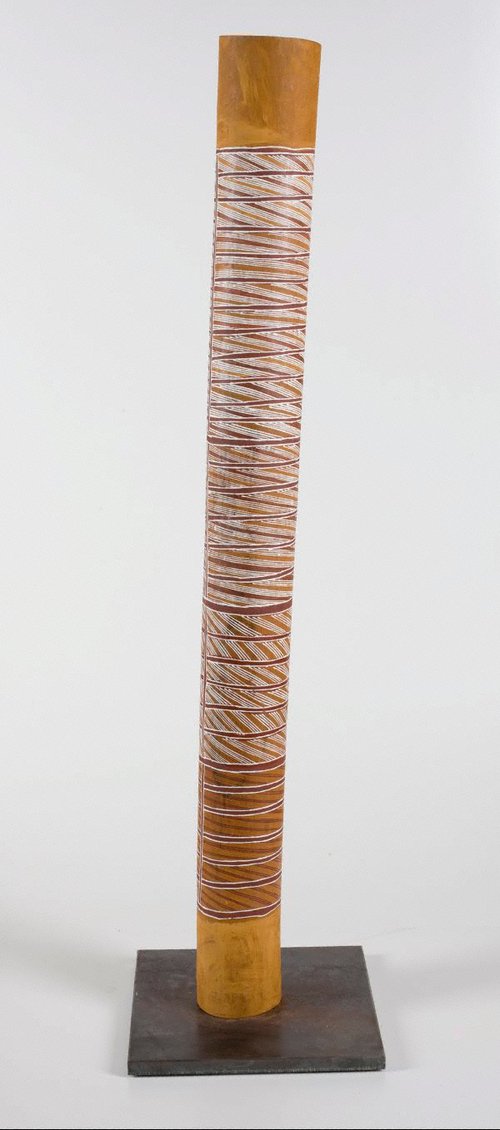Title
Badurru (Hollow log)
(1986)
Artist
Philip Gudthaykudthay
Australia
1935 – Oct 2022
Language groups: Galwanuk, Arnhem region, Liyagalawumurr, Arnhem region
-
Details
- Other Titles
- Bone coffin
Log coffin - Place where the work was made
-
Ramingining
→
Central Arnhem Land
→
Northern Territory
→
Australia
- Date
- (1986)
- Media category
- Sculpture
- Materials used
- natural pigments on wood
- Dimensions
- 148.5 x 13.7 x 13.7 cm
- Signature & date
Not signed. Not dated.
- Credit
- Purchased 1986
- Location
- Not on display
- Accession number
- 246.1986
- Copyright
- © Philip Gudthaykudthay, Bula'bula Arts/Copyright Agency
- Artist information
-
Philip Gudthaykudthay
Works in the collection
- Share
-
-
About
'There is a little creek near there, called Gunyunmirringa, and in that creek is where the practice of the first hollow log ceremony took place for the Dhuwa people. They say that this is where a crow made one of these logs ... The soul is indestructible. It stays behind ... The log is thought of as the flesh, as the skin, and putting the bones inside is like putting the soul back into the body ... This is painted with a design like a body design ...'
Used as a repository for the bones of deceased people, badurru (hollow log coffins) have been created for exhibition since the 1950s. They refer potently to the spiritual universe beyond earthly existence. The shapes of the cylindrical logs lend themselves to the calm, insistent rhythm of Philip Gudthaykudthay's geometric designs, which the artist has also successfully translated onto bark paintings.
In the work 'Badurru and Dindin', 1985, equidistant black bands encircle the badurru. They define the two sections painted with distinct patterns, signifying Gudthaykudthay's clan lands at Gurryunmirringa, forested country to the east of Ramingining, Arnhem Land. The design on 'Badurru (Hollow log)', 1986, is another variation, with the rectangular grid containing unhatched diagonal stripes. Bands of yellow ochre at either end magnify its intense golden hue, 'Badurru (Hollow log)', 1986, is entirely covered in Gudthaykudthay's clan design and has a band of thick black beeswax anchoring the lower edge.
Philip Gudthaykudthay was born to the east of Ramingining in central Arnhem Land. Following the death of his parents he was adopted by a Murrungun clan family and initiated around 1949 at Gatji lagoon. Gudthaykudthay has worked as a crocodile hunter, stockman and stationhand. He now lives and paints at Ramingining, his mother's country, where he is known as 'Pussycat' (a reference to the native cat, one of his ancestral totems).
Gudthaykudthay had his first solo exhibition in 1983 at the Gary Anderson Gallery, Sydney. He has had several exhibitions in the years since then, and has also exhibited in many group shows. In 1997, Gudthaykudthay participated in printmaking workshops held in Ramingining, and his paintings were included in the exhibition, 'The Painters of the Wagilag Sisters Story 1937-1997', held at the National Gallery of Australia, Canberra.
Ken Watson in 'Tradition today: Indigenous art in Australia', Art Gallery of New South Wales, Sydney, 2004
© Art Gallery of New South Wales
-
Places
Where the work was made
Ramingining
-
Exhibition history
Shown in 2 exhibitions
A material thing - Objects from the collection, Art Gallery of New South Wales, Sydney, 31 Aug 1998–09 Feb 1999
One sun, one moon, Art Gallery of New South Wales, Sydney, 03 Jul 2007–02 Dec 2007
-
Bibliography
Referenced in 3 publications
-
Djon Mundine, One sun one moon: Aboriginal art in Australia, ‘The concept of style in Central Arnhem Land’, pg. 99-104, Sydney, 2007, 105 (colour illus.).
-
Hetti Perkins and Ken Watson, A material thing - objects from the collection, Sydney, 1999.
-
Ken Watson, Tradition today: Indigenous art in Australia, 'Philip Gudtheykudthay', pg. 52, Sydney, 2004, 52, 53 (colour illus., right image).
-



